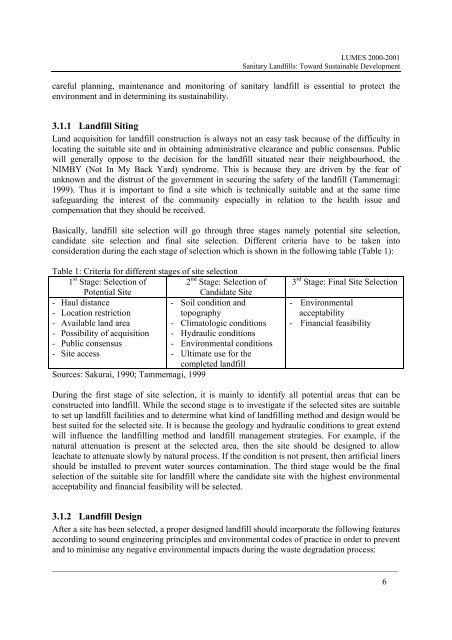Sanitary Landfills: Toward Sustainable Development - lumes
Sanitary Landfills: Toward Sustainable Development - lumes
Sanitary Landfills: Toward Sustainable Development - lumes
Create successful ePaper yourself
Turn your PDF publications into a flip-book with our unique Google optimized e-Paper software.
LUMES 2000-2001<br />
<strong>Sanitary</strong> <strong>Landfills</strong>: <strong>Toward</strong> <strong>Sustainable</strong> <strong>Development</strong><br />
careful planning, maintenance and monitoring of sanitary landfill is essential to protect the<br />
environment and in determining its sustainability.<br />
3.1.1 Landfill Siting<br />
Land acquisition for landfill construction is always not an easy task because of the difficulty in<br />
locating the suitable site and in obtaining administrative clearance and public consensus. Public<br />
will generally oppose to the decision for the landfill situated near their neighbourhood, the<br />
NIMBY (Not In My Back Yard) syndrome. This is because they are driven by the fear of<br />
unknown and the distrust of the government in securing the safety of the landfill (Tammemagi:<br />
1999). Thus it is important to find a site which is technically suitable and at the same time<br />
safeguarding the interest of the community especially in relation to the health issue and<br />
compensation that they should be received.<br />
Basically, landfill site selection will go through three stages namely potential site selection,<br />
candidate site selection and final site selection. Different criteria have to be taken into<br />
consideration during the each stage of selection which is shown in the following table (Table 1):<br />
Table 1: Criteria for different stages of site selection<br />
1 st Stage: Selection of 2<br />
Potential Site<br />
nd Stage: Selection of<br />
Candidate Site<br />
- Haul distance<br />
- Soil condition and<br />
- Location restriction<br />
topography<br />
- Available land area - Climatologic conditions<br />
- Possibility of acquisition - Hydraulic conditions<br />
- Public consensus<br />
- Environmental conditions<br />
- Site access<br />
- Ultimate use for the<br />
completed landfill<br />
Sources: Sakurai, 1990; Tammemagi, 1999<br />
3 rd Stage: Final Site Selection<br />
- Environmental<br />
acceptability<br />
- Financial feasibility<br />
During the first stage of site selection, it is mainly to identify all potential areas that can be<br />
constructed into landfill. While the second stage is to investigate if the selected sites are suitable<br />
to set up landfill facilities and to determine what kind of landfilling method and design would be<br />
best suited for the selected site. It is because the geology and hydraulic conditions to great extend<br />
will influence the landfilling method and landfill management strategies. For example, if the<br />
natural attenuation is present at the selected area, then the site should be designed to allow<br />
leachate to attenuate slowly by natural process. If the condition is not present, then artificial liners<br />
should be installed to prevent water sources contamination. The third stage would be the final<br />
selection of the suitable site for landfill where the candidate site with the highest environmental<br />
acceptability and financial feasibility will be selected.<br />
3.1.2 Landfill Design<br />
After a site has been selected, a proper designed landfill should incorporate the following features<br />
according to sound engineering principles and environmental codes of practice in order to prevent<br />
and to minimise any negative environmental impacts during the waste degradation process:<br />
______________________________________________________________________________<br />
6

















